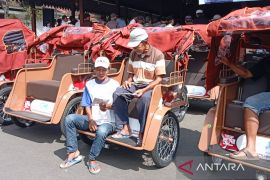Nanning, China, Oct. 21, 2022 (ANTARA/Xinhua-AsiaNet) - In recent years, Guangxi Zhuang Autonomous Region has released a series of policies to promote the development of "night economy". In response, all parts of the region have actively carried out "night economy" activities such as night eating-out, night viewing, night entertainment, night shopping and etc., through which the "traveler flow" turns into "traveler stay", thereby effectively activating night consumption and boosting economic growth.
A number of national-level night culture and tourism consumption clusters, such as the "Three Streets and Two Alleys" in Nanning, ASEAN Culture and Tourism Area in Nanning, Yueye Dong Village in Liuzhou, East West Street in Guilin, Rongchuang Tourist Resort in Guilin, and Taiping Ancient Town Block in Chongzuo, have become the model for the development of "night economy" in Guangxi.
To upgrade night consumption, Guangxi recently issued 'Several Measures to Further Promote Consumption', proposing to encourage sellers to stay open late and focus on cultivating and building a number of night culture and tourism consumption clusters that integrate night dining, night shopping, night tour, etc. with strong driving ability, so as to guide all localities to make efforts in "differentiation", "specialization" and "characterization" and promote upgrading of night consumption carriers.
"Night economy has played an increasingly important engine role in releasing consumption vitality and promoting economic growth. We will continue to promote the innovation and development of night economy, advance the integration of business, culture and tourism, vigorously develop new business formats and foster new scenes of night consumption, activate new hot spots of night consumption, and empower the upgrade of urban economy," said Lai Fuqiang, deputy director of the Department of Culture and Tourism of Guangxi Zhuang Autonomous Region.
The "Three Streets and Two Alleys", located in the downtown Nanning, are historically an important commercial and cultural landmark in Nanning, also known as the first batch of national-level travel and leisure blocks. The lane culture in southern China represented by the "Three Streets and Two Alleys" arose in the Song Dynasty. The area where it is located is the birthplace of Yongzhou Ancient Town can be traced back to the Song Dynasty, and it is also the base site of the city wall and moat of Nanning in the Ming and Qing Dynasties.
In recent years, promoted by multiple favorable policies such as old city renovation and urban renewal, the once outdated "Three Streets and Two Alleys" have also taken a new lease of life. Through innovative and diversified business formats, the cultural and historical heritage typical of Nanning has been displayed thereby.
When the evening lights are lit, a large number of tourists visit and stroll about the architectural blocks reminiscent of those in the Ming and Qing Dynasties. In the bazaar brimming with an antique flavor are many special stalls such as sugar painting, oil tea making, paper fan painting, and handicrafts, presenting a dazzling array of beautiful exhibits. Street vendors peddle along the street, and residents and tourists come and go in the hustle and bustle.
It is the worldly life brimming with vitality that warms the hearts of people the most. The "night economy" plays a significant role in stimulating domestic demand and serving people's livelihood, and its prosperity has become an indicator for measuring the vitality of a city.
As the night closes in, the street market in Nanning ASEAN Culture and Tourism Area is as bright as daytime, flowing with light and color. In recent years, centering on the theme of "Window of ASEAN - Charm of Qingxiu", Nanning ASEAN Culture and Tourism Area has organically integrated ASEAN elements with Zhuang customs, which is reflected in urban construction and leisure consumption, thereby becoming a window to show the innovative achievements reaped by China-ASEAN openness and cooperation.
Nowadays, Nanning ASEAN Culture and Tourism Area has gathered more than 2,000 night business entities, and developed eight night-themed consumption activities: Green City Night Scene, ASEAN Night Banquet, Mixc Night Shopping, Fashion Night Entertainment, Xinbo Night Accommodation, Zhuang Brocade Night Show, Green Hill Night Health Care and Book Sea Night Reading.
On the night of late autumn, East West Street of Guilin is ablaze with lights, bustling with vitality and full of tourists. East West Street, famous for its "old city walls and streets", has witnessed the rise and fall of Guilin for more than 1,000 years and held high historical and cultural value. In 2013, CPC Guilin Municipal Committee and People's Government of Guilin Municipality launched the restoration and reconstruction project of East West Street to build a historical, cultural and leisure street by adding modern elements while preserving its original appearance.
After the opening of East West Street in 2016, it immediately became a new landmark of cultural tourism in downtown Guilin. The East West Street actively introduces characteristic brands in terms of business format, gathers famous brands and shops, and provides one-stop services for eating, drinking, playing, enjoying, traveling, shopping and entertainment.
"There is a large flow of people in the East West Street, especially during holidays and evenings. I will come here to sell trinkets after work, and the income is very good," said Ms. Zhang, the owner of the trinket stall.
Source: The Department of Culture and Tourism of Guangxi Zhuang Autonomous Region
Reporter: PR Wire
Editor: PR Wire
Copyright © ANTARA 2022












